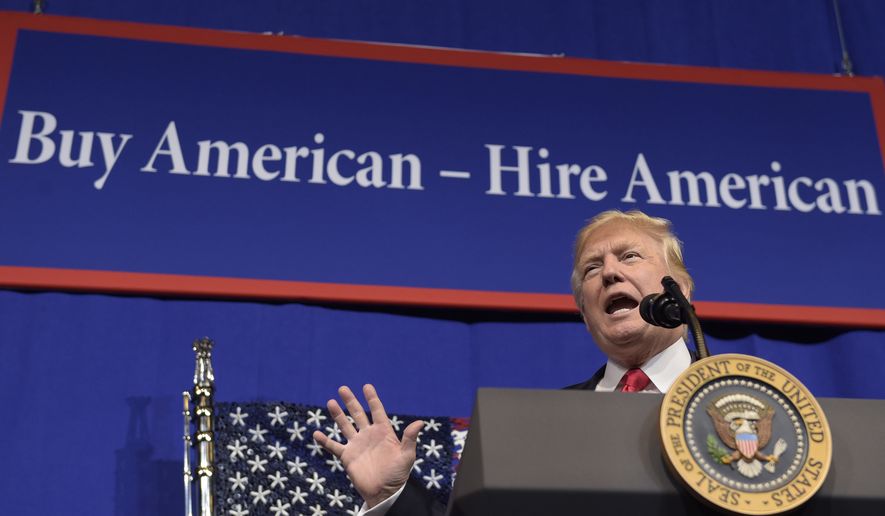Federal law requires agencies emphasize the purchase of American-made products — but it turns out that’s tough to do when the government doesn’t even track where most of what it buys is made.
A new Government Accountability Office report this week says nearly $200 billion worth of federal contracts last year were for products that could be subject to buy-American requirements.
But the government accountants concluded almost $8 billion of that counted as “foreign end products.”
In one instance Homeland Security bought $18 million in aircraft parts it reported were made in the U.S. In reality they were Italian-produced spare parts.
The GAO said agencies don’t always provide training or have the resources to properly track their supply chains to comply with the law.
Sen. Chris Murphy, the Connecticut Democrat who requested the report, seized on the aircraft parts purchase and said the report should be a wakeup call.
“These laws are in place for a reason,” he said. “If President Trump is serious when he says, ’America first,’ his administration must get serious about complying with laws that help our manufacturers make products to defend our country.”
Buy-American laws date back to the 1930s Great Depression, and generally push agencies to look to U.S. manufacturers, except in cases of emergency or, particularly for the military bases overseas, when buying local makes more sense logistically.
The Trump administration has said it would make buy-American a priority, and lawmakers from the manufacturing heartland have tried to invigorate the rules with new legislation.
Ohio’s bipartisan senators, for instance, proposed a law last January that would have created a Buy American website, streamlining the process for bureaucrats and making it easier to track compliance, but that bill has gone nowhere.
“It’s simple. American tax dollars should support American jobs. Period,” Sen. Sherrod Brown, Ohio Democrat, said. “This report underscores the need for the federal government to do more when it comes to implementing Buy American.”
Both Mr. Brown and Sen. Rob Portman, Ohio Republican, plan to reintroduce their legislation in the next Congress, officials said.
Bureaucrats trying to comply with the law report difficulties and confusion, which is perhaps understandable given they must abide by a much more complicated process than looking for a “Made in USA” label.
“There is a bureaucracy cost to Buy America,” said the Cato Institute’s Chris Edwards, who opposes the concept on free trade and cost-savings grounds. “Tens of thousands of federal workers need to be trained on the complex rules, and U.S. businesses get buried in more government paperwork.”
Some countries’ products are exempted due to trade treaties, for example, or executive waiver, something available to presidents since 1979. Different countries have different price thresholds over which the Buy American Act does not apply, and then there are various definitions of what constitutes an “end product” and whether that must be of American origin or include American parts.
The GAO attributed some of the issues to “coding errors,” “systems limitations” and poor guidance.
At the Department of Veterans Affairs, for example, contracting officials said they “struggled with the details of awarding contracts subject to Buy American Act requirements because they are not provided sufficient agency-specific training and guidance on the topic.”
Some agencies probed by the GAO said they’ve already taken steps to boost training for employees.
The Pentagon estimated some 18,000 of its employees would have completed a new training course, “that specifically focuses on the requirements and implementation of the Buy American Act,” by September 2018, according to the Defense Department’s official response to GAO.
Homeland Security put training courses into effect in 2017 that focussed on the Buy American Act provisions and estimated that “94 percent of its contracting staff had taken the required course as of April 2018,” the report said.
The White House did not immediately respond to questions about the report sent it Tuesday and Wednesday.
The GAO stressed that is is drawing no conclusions on the figures.
“There are some folks in this town who think there is a lot going out the door in terms of foreign spending, and our numbers show it’s about 5 percent,” agency spokesman William T. Woods said. “Some people might think that’s not too big a problem, some people might think that’s way too much — the GAO isn’t making any statement about what policy conclusions should be drawn from this.”
• James Varney can be reached at jvarney@washingtontimes.com.




Please read our comment policy before commenting.